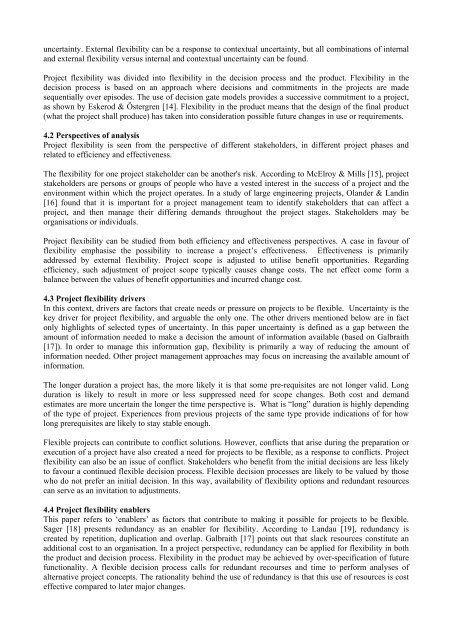Link to thesis - Concept - NTNU
Link to thesis - Concept - NTNU
Link to thesis - Concept - NTNU
You also want an ePaper? Increase the reach of your titles
YUMPU automatically turns print PDFs into web optimized ePapers that Google loves.
uncertainty. External flexibility can be a response <strong>to</strong> contextual uncertainty, but all combinations of internaland external flexibility versus internal and contextual uncertainty can be found.Project flexibility was divided in<strong>to</strong> flexibility in the decision process and the product. Flexibility in thedecision process is based on an approach where decisions and commitments in the projects are madesequentially over episodes. The use of decision gate models provides a successive commitment <strong>to</strong> a project,as shown by Eskerod & Östergren [14]. Flexibility in the product means that the design of the final product(what the project shall produce) has taken in<strong>to</strong> consideration possible future changes in use or requirements.4.2 Perspectives of analysisProject flexibility is seen from the perspective of different stakeholders, in different project phases andrelated <strong>to</strong> efficiency and effectiveness.The flexibility for one project stakeholder can be another's risk. According <strong>to</strong> McElroy & Mills [15], projectstakeholders are persons or groups of people who have a vested interest in the success of a project and theenvironment within which the project operates. In a study of large engineering projects, Olander & Landin[16] found that it is important for a project management team <strong>to</strong> identify stakeholders that can affect aproject, and then manage their differing demands throughout the project stages. Stakeholders may beorganisations or individuals.Project flexibility can be studied from both efficiency and effectiveness perspectives. A case in favour offlexibility emphasise the possibility <strong>to</strong> increase a project’s effectiveness. Effectiveness is primarilyaddressed by external flexibility. Project scope is adjusted <strong>to</strong> utilise benefit opportunities. Regardingefficiency, such adjustment of project scope typically causes change costs. The net effect come form abalance between the values of benefit opportunities and incurred change cost.4.3 Project flexibility driversIn this context, drivers are fac<strong>to</strong>rs that create needs or pressure on projects <strong>to</strong> be flexible. Uncertainty is thekey driver for project flexibility, and arguable the only one. The other drivers mentioned below are in fac<strong>to</strong>nly highlights of selected types of uncertainty. In this paper uncertainty is defined as a gap between theamount of information needed <strong>to</strong> make a decision the amount of information available (based on Galbraith[17]). In order <strong>to</strong> manage this information gap, flexibility is primarily a way of reducing the amount ofinformation needed. Other project management approaches may focus on increasing the available amount ofinformation.The longer duration a project has, the more likely it is that some pre-requisites are not longer valid. Longduration is likely <strong>to</strong> result in more or less suppressed need for scope changes. Both cost and demandestimates are more uncertain the longer the time perspective is. What is “long” duration is highly dependingof the type of project. Experiences from previous projects of the same type provide indications of for howlong prerequisites are likely <strong>to</strong> stay stable enough.Flexible projects can contribute <strong>to</strong> conflict solutions. However, conflicts that arise during the preparation orexecution of a project have also created a need for projects <strong>to</strong> be flexible, as a response <strong>to</strong> conflicts. Projectflexibility can also be an issue of conflict. Stakeholders who benefit from the initial decisions are less likely<strong>to</strong> favour a continued flexible decision process. Flexible decision processes are likely <strong>to</strong> be valued by thosewho do not prefer an initial decision. In this way, availability of flexibility options and redundant resourcescan serve as an invitation <strong>to</strong> adjustments.4.4 Project flexibility enablersThis paper refers <strong>to</strong> ‘enablers’ as fac<strong>to</strong>rs that contribute <strong>to</strong> making it possible for projects <strong>to</strong> be flexible.Sager [18] presents redundancy as an enabler for flexibility. According <strong>to</strong> Landau [19], redundancy iscreated by repetition, duplication and overlap. Galbraith [17] points out that slack resources constitute anadditional cost <strong>to</strong> an organisation. In a project perspective, redundancy can be applied for flexibility in boththe product and decision process. Flexibility in the product may be achieved by over-specification of futurefunctionality. A flexible decision process calls for redundant recourses and time <strong>to</strong> perform analyses ofalternative project concepts. The rationality behind the use of redundancy is that this use of resources is costeffective compared <strong>to</strong> later major changes.
















